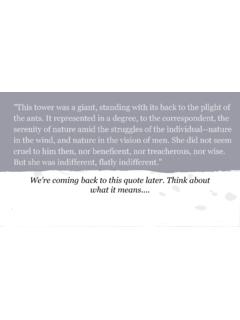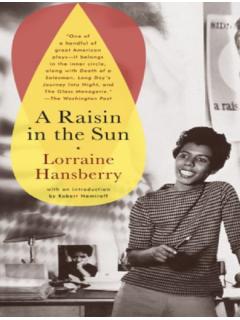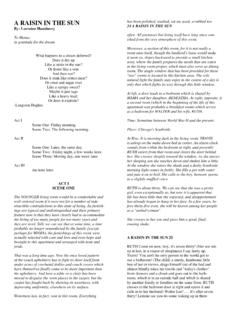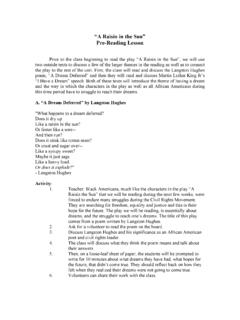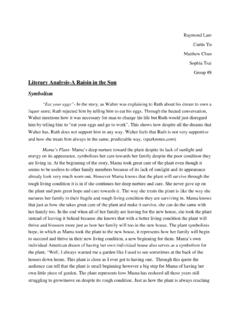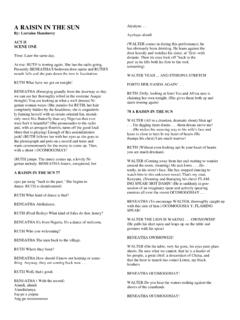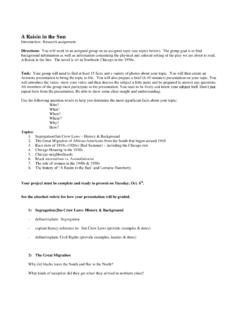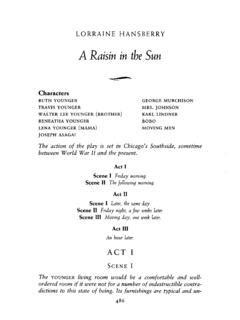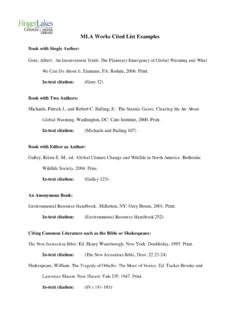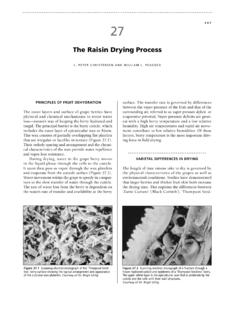Transcription of The Movement LORRAINE HANSBERRY - American Literature
1 Works byLORRAINE HANSBERRYA Raisin in the SunThe Sign in Sidney Brustein s WindowThe Drinking GourdTo Be Young, Gifted and BlackLes BlancsWhat Use Are Flowers?The MovementFIRST VINTAGE BOOK EDITION, DECEMBER 1994 Copyright 1958, 1986 by Robert Nemiroff, as an unpublished workCopyright 1959, 1966, 1984, 1987, 1988 by Robert NemiroffIntroduction copyright 1987, 1988 by Robert NemiroffAll rights reserved under International and Pan- American CopyrightConventions. Published in the United States by Vintage Books, adivision of Random House, Inc., New York, and simultaneously inCanada by Random House of Canada Limited, Toronto. Originallypublished in hardcover in somewhat different form by Random House,Inc., New York, in : Professionals and amateurs are hereby warned that A Raisinin the Sun, being fully protected under the copyright Laws of theUnited States of America, the British Empire, including the Dominionof Canada, and all other countries of the Universal Copyright and BerneConventions, is subject to royalty.
2 All rights, including professional,amateur, motion picture, recitation, lecturing, public reading, radio andtelevision broadcasting, and the rights of translation into foreignlanguages, are strictly reserved. Particular emphasis is laid on thequestion of readings, permission for which must be secured in inquiries should be addressed to the William Morris Agency, 1350 Avenue of the Americas, New York, NY 10019, authorized agents forthe Estate of LORRAINE HANSBERRY and for Robert Nemiroff, acknowledgment is made to Alfred A. Knopf, Inc. forpermission to reprint eleven lines from Dream Deferred ( Harlem )from The Panther and the Lash by Langston Hughes. Copyright 1951 by Langston by of Congress Cataloging-in-Publication DataHansberry, LORRAINE , 1930 raisin in the sun / by LORRAINE HANSBERRY ; with an introductionby Robert Nemiroff. 1st Vintage Books : 978-0-307-80744-11.
3 Afro-Americans History 20th century Drama. I. 1994812 .54 dc20 Mama:in gratitude for the dreamWhat happens to a dream deferred?Does it dry upLike a raisin in the sun ?Or fester like a sore And then run?Does it stink like rotten meatOr crust and sugar over Like a syrupy sweet?Maybe it just sagsLike a heavy does it explode?LANGSTON HUGHES INTRODUCTIONby Robert Nemiroff*This is the most complete edition of A Raisin in the Sunever published. Like the American Playhouse productionfor television, it restores to the play two scenes unknown tothe general public, and a number of other key scenes andpassages staged for the first time in twenty-fifth anniversaryrevivals and, most notably, the Roundabout Theatre sKennedy Center production on which the television pictureis based. The events of every passing year add resonance to ARaisin in the Sun.
4 It is as if history is conspiring to makethe play a classic ; .. one of a handful of great Americandramas .. a raisin in the sun belongs in the inner circle,along with Death of a Salesman, Long Day s Journey intoNight, and The Glass Menagerie. So wrote The New YorkTimes and the Washington Post respectively of HaroldScott s revelatory stagings for the Roundabout in whichmost of these elements, cut on Broadway, were unprecedented resurgence of the work (a dozenregional revivals at this writing, new publications andproductions abroad, and now the television production thatwill be seen by millions) prompts the new in 1959, the play presaged the revolution inblack and women s consciousness and the revolutionaryferment in Africa that exploded in the years following theplaywright s death in 1965 to ineradicably alter the socialfabric and consciousness of the nation and the world.
5 As somany have commented lately, it did so in a manner and toan extent that few could have foreseen, for not only therestored material, but much else that passed unnoticed inthe play at the time, speaks to issues that are nowinescapable: value systems of the black family; concepts ofAfrican American beauty and identity; class andgenerational conflicts; the relationships of husbands andwives, black men and women; the outspoken (if then yetunnamed) feminism of the daughter; and, in the penultimatescene between Beneatha and Asagai, the larger statementof the play and the ongoing struggle it one of the cuts, it should be emphasized, was madeto dilute or censor the play or to soften its statement, foreveryone in that herculean, now-legendary band thatbrought Raisin to Broadway and most specifically theproducer, Philip Rose, and director, Lloyd Richards believed in the importance of that statement with adegree of commitment that would have countenancednothing of the kind.
6 How and why, then, did the cuts comeabout?The scene in which Beneatha unveils her natural haircutis an interesting example. In 1959, when the play waspresented, the rich variety of Afro styles introduced in themid-sixties had not yet arrived: the very few black womenwho wore their hair unstraightened cut it very short. Whenthe hair of Diana Sands (who created the role) wascropped in this fashion, however, a few days before theopening, it was not contoured to suit her: her particularfacial structure required a fuller Afro, of the sort she in factadopted in later years. Result? Rather than vitiate theplaywright s point the beauty of black hair the scenewas cuts were similarly the result of happenstance orunpredictables of the kind that occur in any production:difficulties with a scene, the processes of actors, thedynamics of staging, etc.
7 But most were related to thelength of the play: running time. Time in the context ofbringing to Broadway the first play by a black (young andunknown) woman, to be directed, moreover, by anotherunknown black first, in a theater were black audiencesvirtually did not exist and where, in the entire history of theAmerican stage, there had never been a seriouscommercially successful black drama!So unlikely did the prospects seem in that day, in fact, toall but Phil Rose and the company, that much as someexpressed admiration for the play, Rose s eighteen-montheffort to find a co-producer to help complete the financingwas turned down by virtually every established name in thebusiness. He was joined at the last by another newcomer,David Cogan, but even with the money in hand, not a singletheater owner on the Great White Way would rent to thenew production!
8 So that when the play left New York fortryouts with a six-hundred-dollar advance in New Havenand no theater to come back to had the script andperformance been any less ready, and the response ofcritics and audiences any less unreserved than they provedto be, a raisin in the sun would never have these circumstances the pressures wereenormous (if unspoken and rarely even acknowledged inthe excitement of the work) not to press fate unduly withunnecessary risks. And the most obvious of these was therunning time. It is one thing to present a four-and-a-half-hourdrama by Eugene O Neill on Broadway but a first play(even ignoring the special features of this one) in theneighborhood of even three??? By common consensus,the need to keep the show as tight and streamlined aspossible was manifest.
9 Some things philosophical flights,nuances the general audience might not understand,shadings, embellishments would have to be the time the cuts were made (there were also somevery good ones that focused and strengthened the drama),it was assumed by all that they would in no way significantlyaffect or alter the statement of the play, for there is nothingin the omitted lines that is not implicit elsewhere in, andthroughout, a raisin in the sun . But to think this was toreckon without two factors the future would bring into first was the swiftness and depth of the revolution inconsciousness that was coming and the consequent,perhaps inevitable, tendency of some people to assume,because the world had changed, that any successful work which preceded the change must embody the valuesthey had outgrown. And the second was the nature of theAmerican Baldwin has written that Americans suffer froman ignorance that is not only colossal, but sacred.
10 He isreferring to that apparently endless capacity we havenurtured through long years to deceive ourselves whererace is concerned: the baggage of myth and preconceptionwe carry with us that enables northerners, for example, toshield themselves from the extent and virulence ofsegregation in the North, so that each time an incident ofviolence so egregious that they cannot look past it occursthey are shocked anew, as if it had never happenedbefore or as if the problem were largely pass . (In 1975,when the cast of Raisin, the musical, became involved indefense of a family whose home in Queens, New York City,had been fire-bombed, we learned of a 1972 CityCommissioner of Human Rights Report, citing elevencases in the last eighteen months in which minority-ownedhomes had been set afire or vandalized, a church had beenbombed, and a school bus had been attacked in NewYork City!)
